This article needs additional citations for verification .(May 2014) |

A palloza (also known as pallouza or pallaza) is a traditional dwelling of the Serra dos Ancares of northwest Spain.
This article needs additional citations for verification .(May 2014) |

A palloza (also known as pallouza or pallaza) is a traditional dwelling of the Serra dos Ancares of northwest Spain.
A palloza is a traditional thatched house as found in Leonese county of El Bierzo, Serra dos Ancares in Galicia, and south-west of Asturias; corresponding to Astur tribes area, one of pre Hispano-Celtic inhabitants of northwest Hispania. It is circular or oval, and about ten or twenty metres in diameter and is built to withstand severe winter weather at a typical altitude of 1,200 metres.
The main structure is stone, and is divided internally into separate areas for the family and their animals, with separate entrances. The roof is conical, made from rye straw on a wooden frame. There is no chimney, the smoke from the kitchen fire seeps out through the thatch.
As well as living space for humans and animals, a palloza has its own bread oven, workshops for wood, metal and leather work, and a loom. Only the eldest couple of an extended family had their own bedroom, which they shared with the youngest children. The rest of the family slept in the hay loft, in the roof space.
The palloza is pre-Roman. Pallozas have similarities with the round houses of the Iron Age in Great Britain such as Chysauster in Cornwall and the buildings of the Castro culture.

Its name is actually a corruption of the Galician word "pallaza", first used in the late 19th century by ethnographers such as German Fritz Krüger, who was referring to the material used to make the roof. The traditional name of these buildings is in fact casa de teito or casa de teitu.
The term palloza (spelled palhoça) is also used in the Portuguese language, where it describes a type of small cabin built with wood and thatched roof.

Pallozas were used until the second half of the 20th century, when improved communications brought modern building concepts to the area. Pallozas survive in Galicia, comarca of Os Ancares, and in several areas of Candín and western Asturias. The remarkable pallozas in the Bierzan town of Campo del Agua was largely destroyed by a fire in the mid 1980s. The most famous may be that of Piornedo, which since the 1970s has been an ethnographic museum. New pallozas are used mainly as holiday homes, even in remote areas, where they were not traditionally used.

Galicia is an autonomous community of Spain and historic nationality under Spanish law. Located in the northwest Iberian Peninsula, it includes the provinces of A Coruña, Lugo, Ourense, and Pontevedra.

Thatching is the craft of building a roof with dry vegetation such as straw, water reed, sedge, rushes, heather, or palm branches, layering the vegetation so as to shed water away from the inner roof. Since the bulk of the vegetation stays dry and is densely packed—trapping air—thatching also functions as insulation. It is a very old roofing method and has been used in both tropical and temperate climates. Thatch is still employed by builders in developing countries, usually with low-cost local vegetation. By contrast, in some developed countries it is the choice of some affluent people who desire a rustic look for their home, would like a more ecologically friendly roof, or who have purchased an originally thatched abode.

A yurt or ger (Mongolian) is a portable, round tent covered and insulated with skins or felt and traditionally used as a dwelling by several distinct nomadic groups in the steppes and mountains of Inner Asia. The structure consists of a flexible angled assembly or latticework of wood or bamboo for walls, a door frame, ribs, and a wheel possibly steam-bent as a roof. The roof structure is sometimes self-supporting, but large yurts may have interior posts supporting the crown. The top of the wall of self-supporting yurts is prevented from spreading by means of a tension band which opposes the force of the roof ribs. Yurts take between 30 minutes and 3 hours to set up or take down, and are generally used by between five and 15 people. Nomadic farming with yurts as housing has been the primary life style in Central Asia, particularly Mongolia, for thousands of years.
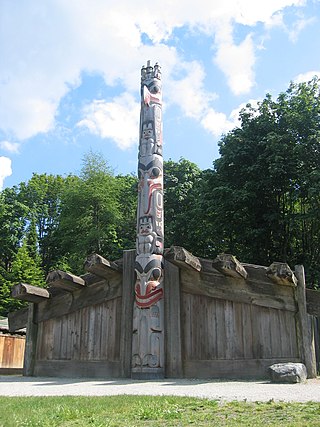
A longhouse or long house is a type of long, proportionately narrow, single-room building for communal dwelling. It has been built in various parts of the world including Asia, Europe, and North America.

Vernacular architecture is building done outside any academic tradition, and without professional guidance. It is not a particular architectural movement or style, but rather a broad category, encompassing a wide range and variety of building types, with differing methods of construction, from around the world, both historical and extant and classical and modern. Vernacular architecture constitutes 95% of the world's built environment, as estimated in 1995 by Amos Rapoport, as measured against the small percentage of new buildings every year designed by architects and built by engineers.

A roundhouse is a type of house with a circular plan, usually with a conical roof. In the later part of the 20th century, modern designs of roundhouse eco-buildings were constructed with materials such as cob, cordwood or straw bale walls and reciprocal frame green roofs.
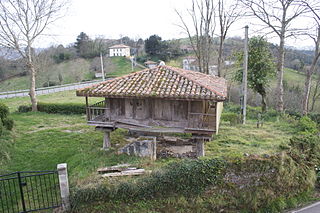
An hórreo is a typical granary from the northwest of the Iberian Peninsula, built in wood or stone, raised from the ground by pillars ending in flat staddle stones to prevent access by rodents. Ventilation is allowed by the slits in its walls.

Galicians are a Romance-speaking European ethnic group from northwestern Spain; they are closely related to the northern Portuguese people and has its historic homeland in Galicia, in the north-west of the Iberian Peninsula. Two Romance languages are widely spoken and official in Galicia: the native Galician and Spanish.
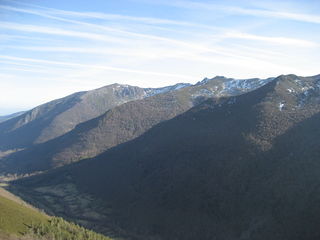
The Serra dos Ancares is a mountain range of the Galician Massif in north-west Spain, extending in a south-westerly direction from the western end of the Cantabrian Mountains in Asturias.

Cervantes is a municipality in the province of Lugo, in the autonomous community of Galicia, Spain. It belongs to the comarca of Os Ancares.
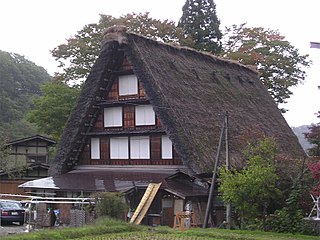
Minka are vernacular houses constructed in any one of several traditional Japanese building styles. In the context of the four divisions of society, Minka were the dwellings of farmers, artisans, and merchants. This connotation no longer exists in the modern Japanese language, and any traditional Japanese-style residence of appropriate age could be referred to as Minka.

Os Ancares is a comarca in the Galician Province of Lugo. The overall population of this local region is 13,888 (2005). It is formed by the municipality of Candín with two slopes, Sil and Navia, and separated by the Ancares pass.

Teito is an Asturian term that designates a type of stone dwelling with a thatched straw or broom roof, found in western Asturias, especially in the Somiedo and Oscos area, and also in Galicia, North West of León, and North East of Portugal.

A baserri is a traditional half-timbered or stone-built type of housebarn farmhouse found in the Basque Country in northern Spain and Southwestern France. The baserris, with their gently sloping roofs and entrance portals, are highly characteristic of the region and form a vital part in traditional Basque societal structures. They are also seen to have played an important role in protecting the Basque language in periods of persecution by providing the language with a very dispersed but substantial speaker base.

The geography of Galicia (Spain) is characterized by the contrast between the low altitude coastal relief and, further inland, by the higher altitude of the Galician Massif which itself offers contrasts between the morphology of the high northern plains and the southern mountains and valleys.

The Galician Massif is a system of mountain ranges in the northwestern corner of the Iberian Peninsula. It is located in Galicia with its southeastern end reaching into the provinces of Zamora and León of Castile and León. Its highest point is Pena Trevinca at 2,127 metres (6,978 ft). Another important peak is Cabeza de Manzaneda.
Suarbol is a village belonging to the shire of Los Ancares situated in the region of El Bierzo within the province of León. Both Suarbol and its neighbouring town Balouta are the last villages of the province of León before crossing towards the province of Lugo

The field of Indigenous architecture refers to the study and practice of architecture of, for and by Indigenous people. It is a field of study and practice in the United States, Australia, Aotearoa, Canada, Arctic area of Sápmi and many other countries where Indigenous people have a built tradition or aspire translate or to have their cultures translated in the built environment. This has been extended to landscape architecture, urban design, planning, public art, placemaking and other ways of contributing to the design of built environments.
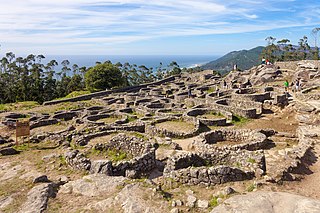
Castro of Santa Trega is an archaeological site located on the hillsides of Mount Santa Trega, in the southwestern Galician municipality of A Guarda, Spain. The site is strategically located overlooking the mouth of the river Miño, at 341 meters above sea level. Belonging to the Castro culture, it's one of the most emblematic and visited Galician forts (castros).
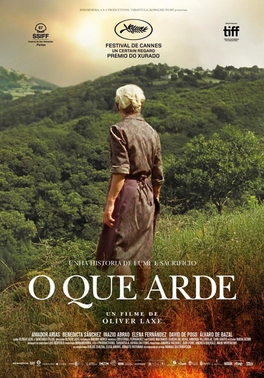
Fire Will Come is a 2019 Galician-language drama film directed by Oliver Laxe. Filmed in the Serra dos Ancares area of Galicia, many of the cast were local people and not professional actors.